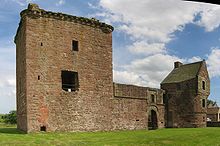Burleigh Castle
Burleigh Castle is a ruined castle on the outskirts of Milnathort , about 2.5 km north of Kinross in the Scottish administrative division of Perth and Kinross . The castle dates from the 15th and 16th centuries. Their ruins now stand on the edge of the A911 road across from a 19th century settlement that was recently converted into a new development area.
history
Burleigh Castle had belonged to the Balfours since 1446 ; John Balfour of Balgarvie had received it from King James II . A residential tower was built on top of it at the end of the 15th or beginning of the 16th century . Sir James Balfour from Pittendreich had the castle expanded at the end of the 16th century by adding a curtain wall , a corner tower and other outbuildings. In 1607 Sir Michael Balfour was raised to Lord Balfour of Burleigh and thus accepted into the nobility.
It is said that Robert Balfour barely escaped death prior to his appointment as 5th Lord when he was sentenced to death by the beheading in 1707 for the murder of the schoolmaster of Inverkeithing . The schoolmaster was unlucky to have married Balfour's childhood sweetheart. After Balfour fled the Tolbooth in Edinburgh , he joined the Jacobite cause and proclaimed the "Old Pretender", James Stuart , as king in Lochmaben . He took part in the Jacobite revolt in 1715, after which he was declared outlawed and his lands fell to the crown. He died in exile in France in 1757 .
The Crown lent the castle to the Irwins , then it fell to the Grahams of Kinross. Today the ruin is a Scheduled Monument under the administration of Historic Scotland . It is free to visit; the key is available in the neighboring house.
The local poet Michael Bruce was inspired by Burleigh Castle and Arnot Tower and wrote the poem "The Lovers" in 1760; it tells the story of Henry and Harriet of the warring families Arnot and Balfour, who allegedly fled to Burleigh Castle.
architecture
The remains of the castle consist of the western part of what was once a square courtyard. In the north-west corner, the former residential tower has remained largely intact (although one of the windows on the first floor has been "enlarged" significantly); it has three full floors and an attic. The 1.5 meter thick walls rise to the consoles that once supported the parapet . The roof and false ceilings no longer exist today, only the vaulted basement has been preserved. The spiral staircase in the northeast corner originally led up to the Caphouse and provided access to the parapet.
To the southwest of it is a corner tower from the 16th century, two stories above the basement with the roof still intact. The tower has a round cross-section at the bottom, and a top with a square cross-section. This is a particularly beautiful example of the Scottish Baronial Style of that time. The masonry is very well preserved. Both this tower and the donjon have loopholes around their bases so that attackers could be repelled. The corner tower has small, round pistol holes at the level of the Caphouse , even if these are more likely to be made there for decorative than for defense reasons. The year 1582 is carved into the north gable , as are the initials SIB and MB (for Sir James Balfour and his wife Margaret Balfour). Both towers are connected by a section of the curtain wall with an archway. Even if this component now only consists of a thin layer of masonry, it was once located in front of a two-story gatehouse . With its brickwork band, its roofing over the gate entrance and its walling of an earlier coat of arms, this wall is an excellent example of small but sophisticated architectural details of this time in Scotland (probably contemporary with the round corner tower). A defensive moat may have surrounded the enclosure in the past.
swell
- Martin Coventry: The Castles of Scotland . 3. Edition. Goblinshead, 2001.
- Maurice Lindsay: The Castles of Scotland . Constable, 1986.
- Entry on Burleigh Castle in Canmore, Historic Environment Scotland database
- Burleigh Castle . Royal Commission for Ancient and Historical Monuments of Scotland. Retrieved March 27, 2017.
Web links
- Burleigh Castle . Historic Scotland . Retrieved March 27, 2017.
Coordinates: 56 ° 13 ′ 33.2 " N , 3 ° 24 ′ 23.4" W.

